
The forest behind my house is already becoming something new, I notice, as I walk trails that used to be shady. With so many fallen giants, the floor now lies under open sky. I count sprouting acorns by the dozens, arching their necks and reaching for a new bonanza of sunlight. I have so many hopes for this place I love. Mostly that we’ll rise like these seedlings from our scoured landscape, blessed with the kindness we’ve shared with our neighbors and the will to extend our care to those who follow behind us on these paths.
~ Barbara Kingsolver
(Southern Living, May 2025, “The Heart of Appalachia”)
On September 27 last year Hurricane Helene tore through Appalachia, affecting the community in Virginia where author Barbara Kingsolver lives. It also devastated 29 of North Carolina’s 100 counties, which are part of the same geographic region. (The county where we live is in the Piedmont region.) For some reason I never mentioned this disaster on this blog last year, probably because I couldn’t process what I was learning about it in real time.
Our grandchildren had no school that day so we had planned to take them to the Carolina Tiger Rescue. The day before, the weather forecasters warned of torrential rain for our area but the tour is by reservation only and the website said it would happen rain or shine. So we were prepared and bought rain ponchos for the four of us. But that morning the Rescue cancelled the tour and we stayed home. I’m glad we didn’t risk getting caught in a flash flood on the roads. It rained a lot and we had two tornado warnings during the day, which sent us to hunker down in the bathroom, but thankfully we weren’t hit. The disruption to our lives was nothing compared to what was happening to our neighbors only a few hours away.
A year earlier in October, we had stayed for a weekend getaway in the beautiful town of Black Mountain. We had a wonderful time walking through the town, visiting Mount Mitchell, hiking the Balsam Nature Trail in the state park, and driving along the scenic Blue Ridge Parkway. Little did we know Black Mountain would experience catastrophic flooding from the storm. Roads and bridges were damaged or washed away. The pictures we saw on the news were shocking and sobering. But since then the stories being shared of kind people helping one another have been heartwarming. I hope we can plan another visit some day.
However, the severely limited federal response under the current administration has been disturbing. According to our governor:
In addition to the $13.5 billion that I am requesting of Congress in new appropriations, North Carolina has yet to receive billions of dollars that Congress worked together on a bipartisan basis to appropriate last December. Just as I asked in February, I am urging federal agencies to take action to unlock those funds so we can put them to work as soon as possible where they are desperately needed.
We are grateful for every dollar that brings us a step closer to recovery, yet current federal financial support is not enough. In total, federal support amounts to approximately 9% of the total damage western North Carolina suffered. Many of the largest, most devastating storms, like Katrina, Maria, and Sandy, saw upwards of 70% of damage covered by federal funding, and from available historical data, the federal government has typically covered between 40 and 50 percent of costs caused by major hurricanes. The people of North Carolina deserve a fair shake, just like the residents of other states and territories.
~ Gov. Josh Stein
(Hurricane Helene Recovery, September 15, 2025, Federal Funding Request)






























































































